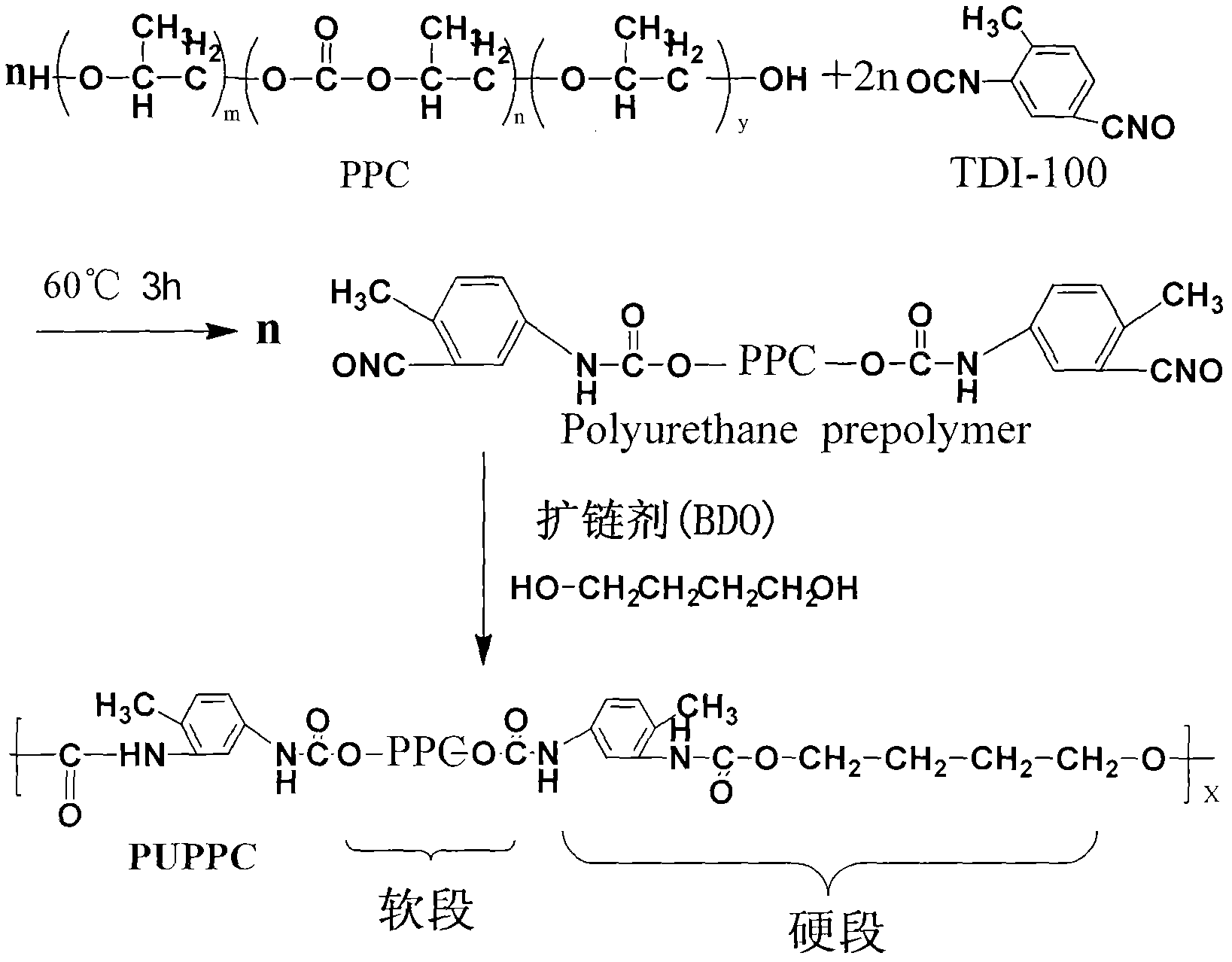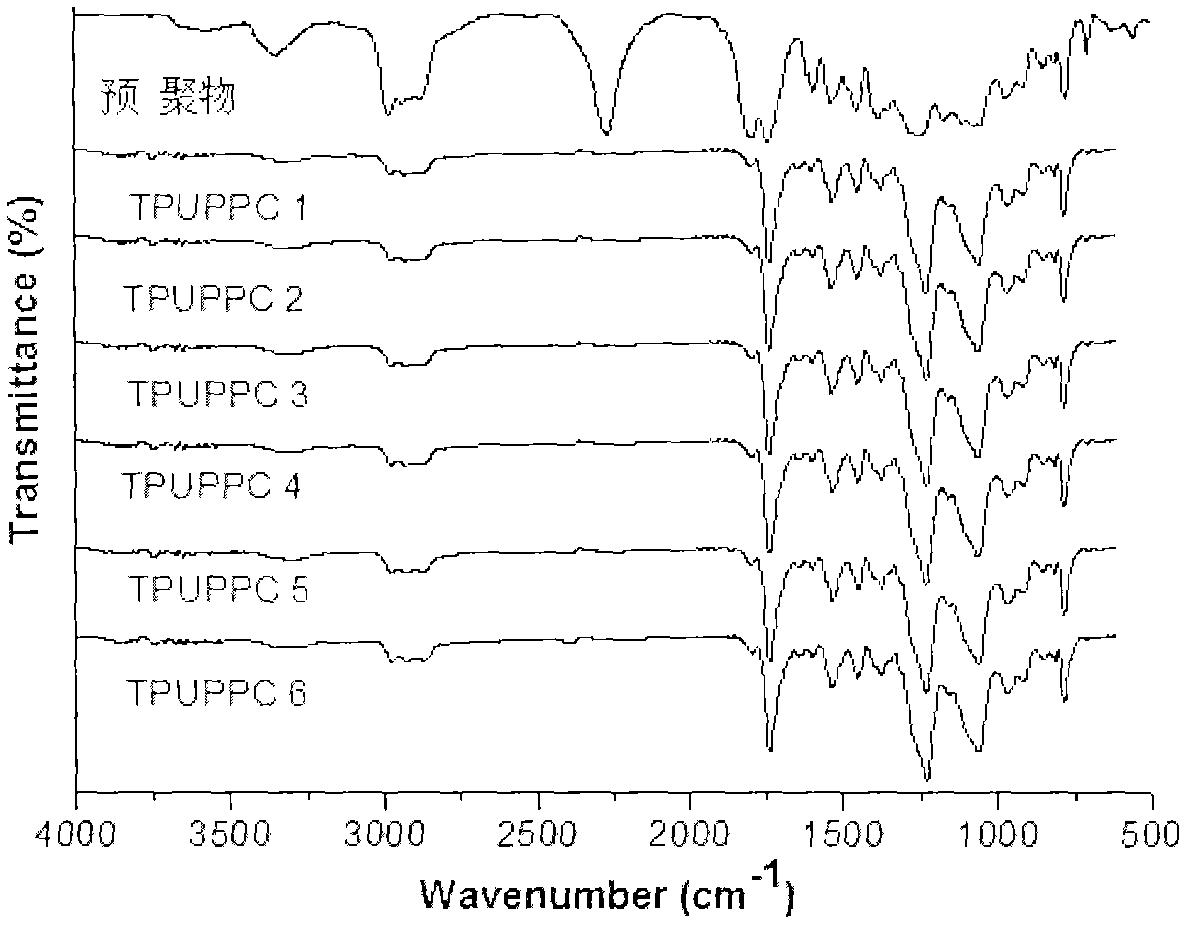Preparation of thermoplastic polyurethane elastomer with polypropylene carbonate as soft segment
A technology of polypropylene carbonate and thermoplastic polyurethane, which is applied in the field of preparing thermoplastic polyurethane elastomers, can solve the problems of inconvenient production and processing, complex manufacturing process and high requirements, and achieve the effects of low production cost, free adjustment of tensile properties, and excellent performance
- Summary
- Abstract
- Description
- Claims
- Application Information
AI Technical Summary
Problems solved by technology
Method used
Image
Examples
Embodiment 1
[0015] Raw materials: 36 g of PPC (molecular weight: 2650), 5.76 g of TDI, 1.5 g of 1,4-butanediol, 0.2 g of dibutyltin dilaurate, and 50 g of ethyl acetate.
[0016] The operation process is as follows: first put TDI into a three-necked flask, then add ethyl acetate and dibutyltin dilaurate. Polypropylene carbonate polyol (PPC) was slowly added dropwise into a three-necked flask in a constant pressure funnel, and the reaction temperature was maintained at 70°C. After reacting for 3 hours, add 1,4 butanediol to carry out chain extension reaction. After reacting for 2 hours, pour the viscous liquid onto a polytetrafluoroethylene board to lay a film. After natural drying for 24 hours, the obtained film is vacuum-dried at 60°C for 24 hours. Obtain the sample, and the sample is used for infrared qualitative analysis and tensile strength test. The experimental data are as follows: figure 2 , as shown in TPUPPC 1 in Table 1.
Embodiment 2
[0018] Raw materials: 30g of PPC (molecular weight: 2650), 5.95g of TDI, 1.6g of ethylene glycol (EO), 0.1g of stannous zincate, and 50g of acetone.
[0019] The operation process is as follows: first put TDI into a three-necked flask, then add acetone (solvent) and stannous zincate. Polypropylene carbonate polyol (PPC) was slowly added dropwise into a three-necked flask in a constant pressure funnel, and the reaction temperature was maintained at 75°C. After reacting for 2 hours, add ethylene glycol (EO) to carry out chain extension reaction. After reacting for 3 hours, pour the viscous liquid onto a polytetrafluoroethylene board to lay a film. After natural drying for 25 hours, the resulting film was vacuum-dried at 60°C for 24 hours. Get the sample, the sample is used for infrared qualitative analysis and tensile strength test, the experimental data figure 2 , as shown in TPUPPC 2 in Table 1.
Embodiment 3
[0021] Raw materials: 25 g of PPC (molecular weight: 2650), 6.11 g of TDI, 2.2 g of 1,4-butanediol (BDO), 0.1 g of stannous zincate, and 50 g of ethyl acetate.
[0022] The operation process is as follows: first put TDI into a three-necked flask, and then add ethyl acetate (solvent) and stannous zincate. Polypropylene carbonate polyol (PPC) was slowly added dropwise into a three-necked flask in a constant pressure funnel, and the reaction temperature was maintained at 65°C. After reacting for 4 hours, add 1,4 butanediol (BDO) to carry out chain extension reaction. After reacting for 3 hours, pour the viscous liquid onto a polytetrafluoroethylene board to lay a film. Vacuum drying for 24 hours to obtain the sample, the sample for infrared qualitative analysis and tensile strength test, experimental data figure 2 , as shown in TPUPPC 3 in Table 1.
PUM
 Login to View More
Login to View More Abstract
Description
Claims
Application Information
 Login to View More
Login to View More - R&D
- Intellectual Property
- Life Sciences
- Materials
- Tech Scout
- Unparalleled Data Quality
- Higher Quality Content
- 60% Fewer Hallucinations
Browse by: Latest US Patents, China's latest patents, Technical Efficacy Thesaurus, Application Domain, Technology Topic, Popular Technical Reports.
© 2025 PatSnap. All rights reserved.Legal|Privacy policy|Modern Slavery Act Transparency Statement|Sitemap|About US| Contact US: help@patsnap.com



